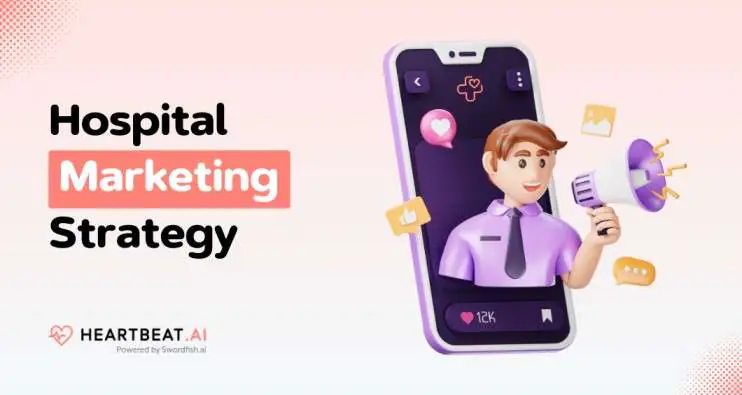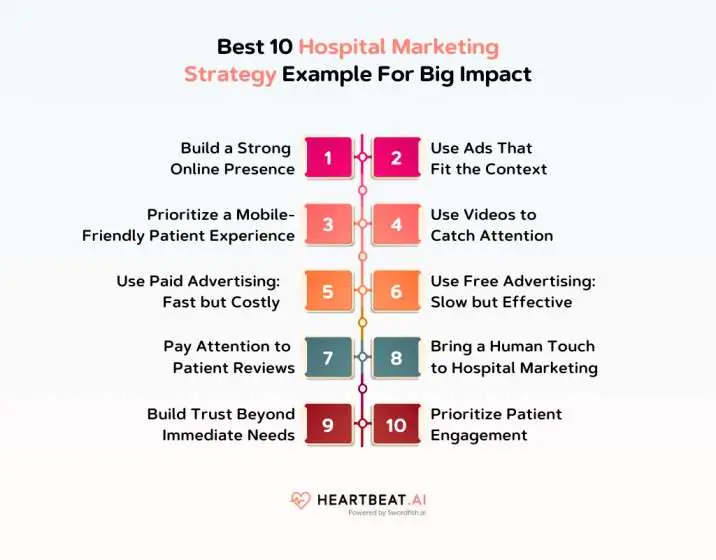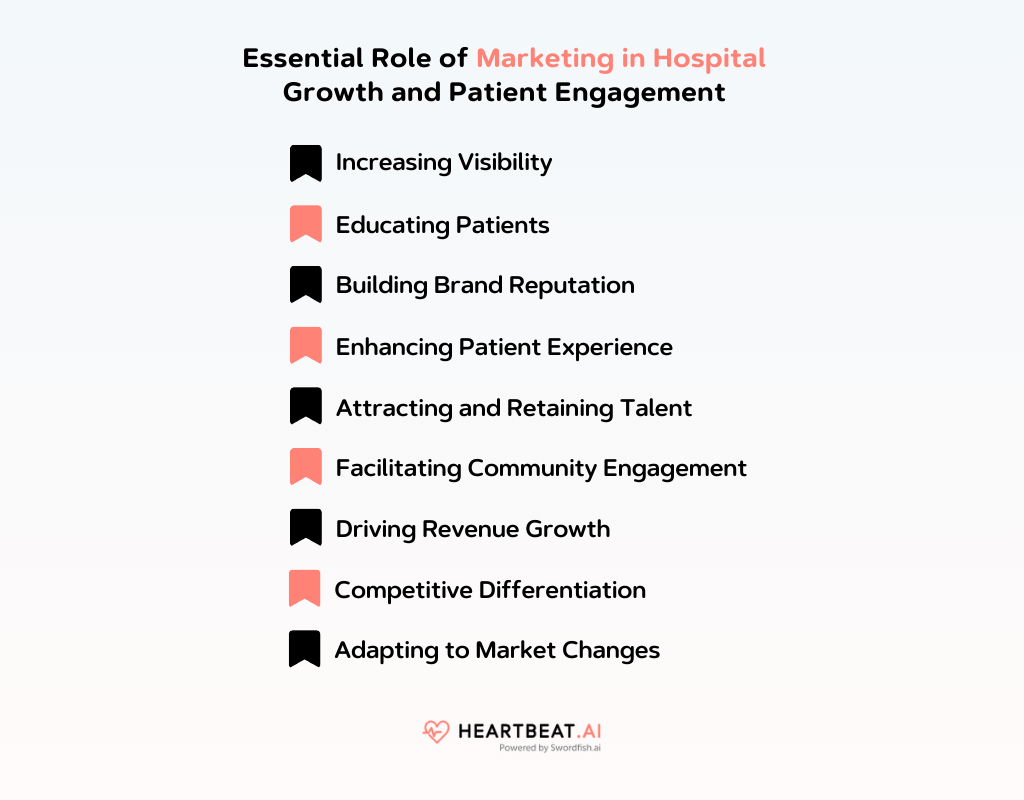
Marketing strategy for hospitals is changing fast as people are now looking online to find where to go for health care. It means hospitals need not just to reach out to these potential patients but also to build real, lasting connections with them.
The push to stand out is significant, especially with hospital ad spending going way up—from $16.7 billion in 2019 to an expected $22.7 billion. With so many hospitals fighting for attention, how do you make sure yours gets noticed and brings in more patients?
The secret is having a smart hospital marketing strategy. But what are the best marketing plans for hospitals?
- Building a strong online presence
- Using ads
- Using catchy and relevant videos
- Paying attention to reviews.
Here are just 4 strategies but there are more. Keep reading to learn some top strategies that can help your hospital grow its reputation and bring in more patients.
What’s on this page:
What is Hospital Marketing?
Hospital marketing is about promoting a hospital’s services to attract new patients while maintaining a good relationship with current ones. It employs a mix of strategies like online advertising, social media, and community involvement to reach out and connect with the community.
The goal is to not only highlight the services offered but also to build trust and a positive reputation. By targeting the right audience, hospitals aim to encourage more people to choose them for their healthcare needs, ultimately supporting the hospital’s growth.
To execute your hospital marketing you might sometimes need a list of other hospital and healthcare professionals. In that case, you can try Heartbeat as we’re providing the most accurate list of healthcare and healthcare organizations.
Best 10 Hospital Marketing Strategy Example For Big Impact

Learn easy marketing tricks for big results at your hospital. Boost online presence, engage with videos/texts, and prioritize patient feedback. Let’s explore the best hospital marketing strategies.
1.Build a Strong Online Presence
Most patients in the US, about 83%, use the internet to find healthcare services. And, health questions make up 7% of all searches on Google. Before someone books an appointment, 60% of them want to see if the clinic has a website.
If they don’t find what they’re looking for or if the information isn’t engaging, 71% are ready to look for another doctor. Using social media, you can share all sorts of things, like educational videos, webinars, articles, and even team up for projects.
It’s a great way to talk directly to people who might come to you for care, and those who already do, making their experience feel more one-on-one.
If you’re not already active on platforms like Twitter, Facebook, LinkedIn, Instagram, and TikTok, it’s time to start. They’re key places to show off what makes your healthcare service stand out.
2. Use Ads That Fit the Context
Ads that match what people are already looking at or thinking about work 32% better than just showing ads based on age or gender. A study showed these kinds of ads grab over three times more attention than the usual ones.
It’s really important to show your hospital’s ads where and when they make sense to people. Imagine someone browsing a cooking blog and coming across an ad for a hospital’s Ob-Gyn department.
Chances are, they’ll ignore it because it doesn’t relate to cooking or why they’re online at that moment. Plus, there’s no way to know if they’re even thinking about healthcare choices right then.
However, if you place your ads on websites focused on healthcare, or next to profiles of doctors, you’re reaching out to people who are already looking into healthcare.
They’re more likely to be interested because they’re actively seeking health information or services, making them more open to what your hospital offers.
3. Prioritize a Mobile-Friendly Patient Experience
Nowadays, everyone expects to find what they need on their mobile devices, and this is especially true for people looking for health information. They want a smooth experience, whether they’re on a computer, phone, or tablet.
However, many healthcare providers are struggling to keep up with making their services easy to use online, which means there’s a big chance for you to stand out by focusing on making your website mobile-friendly.
When your website works well on a phone, it’s easier for people to find what they need, which makes them more likely to use your services. Plus, Google likes websites that are easy to use on phones and shows them higher in search results.
Want to do even better? Use text messages. Most patients like getting reminders for their appointments through texts. By sending texts, you can easily stay in touch with your patients and make their experience with your healthcare services even better.
4. Use Videos to Catch Attention
Videos are really powerful. They can make people want to buy things. In fact, A study showed that 88% of people might buy something after watching a video about it. And most people would rather watch a short video than read an article. So, adding interesting videos to what you offer can draw more attention.
You could make videos that share stories from patients, advice from doctors, or just explain your services. Videos like these can help people feel more connected and trust your hospital.
Watching a doctor talk in a video could even make someone more likely to reach out to them. But, it’s important to keep videos short, ideally less than a minute, to make sure people watch them till the end.
5. Use Paid Advertising: Fast but Costly
Paying for ads, like Google Ads, can quickly get your hospital’s name in front of more eyes, potentially doubling your visitors faster than relying solely on free methods.
However, it’s important to note that the effectiveness of these ads can be limited—only about 6 out of 100 people might click on them. Moreover, paid advertising can be expensive, often consuming a significant portion of your marketing budget.
6. Use Free Advertising: Slow but Effective
On the other hand, free advertising methods, such as search engine optimization (SEO), focus on attracting people who are already looking for healthcare services.
By optimizing your website and content for search engines, you can draw in potential patients more effectively. But, there’s a catch: developing a strong SEO strategy takes time and patience.
7. Pay Attention to Patient Reviews
After the COVID-19 pandemic, people started caring more about the healthcare they receive. More people are now reading reviews about doctors and looking up how good hospitals are than before.
How doctors respond to these reviews, good or bad, really matters to patients. Ignoring a review can make it seem like a hospital doesn’t care about what patients think. It’s important for your hospital to respond to these reviews.
8. Bring a Human Touch to Hospital Marketing
Make your hospital feel more like a community than just a place for care. People often see hospitals as sterile, white spaces. But your hospital has so much more to offer than just cleanliness and excellent care. It’s important to show the human side in your marketing efforts.
Research by PwC found that trust is crucial for people when choosing healthcare, even more than how much it costs. Trust is key because patients are putting their health and well-being in your hands. You want them to feel confident in their choice to come to you.Highlight the faces behind your services, like your doctors and nurses, and talk about the work you do in the community and the events you organize.
Using social media is a great way to show the human side of your hospital by showcasing the healthcare team that makes your place special. This approach helps people connect with your brand on a personal level.
9. Build Trust Beyond Immediate Needs
Hospitals often highlight their ability to provide quick treatments. Yet, the impact of their service extends far beyond just the immediate care. The truth is, most people who come across your hospital’s advertisements might not need medical attention right away.
But, they’ll remember your presence and feel reassured knowing you’re ready to assist when the time comes. The key is to shift the focus towards nurturing long-term relationships rather than just aiming for immediate outcomes.
Cultivating a trustworthy brand is an ongoing journey, requiring steady dedication. With time, your hospital can become the go-to name for patients seeking dependable care.
10. Prioritize Patient Engagement
Make sure your hospital’s marketing plan really focuses on connecting with patients. It’s not just about getting people to come in, but also about keeping them involved and happy.
Having a good plan to engage with patients can make their whole experience better. Hospitals can set up ways to automatically send messages that feel personal, like reminders for appointments, tips for staying healthy, and even birthday wishes. It’s also smart to ask patients what they think through surveys or feedback forms, so you know what you can do better.
Encourage them to use online patient portals to make appointments and look at their medical records. Text messages, WhatsApp, and emails are the best ways to keep in touch with patients.
Essential Role of Marketing in Hospital Growth and Patient Engagement

Here’s a breakdown of the key roles marketing plays in a hospital setting:
Increasing Visibility
Marketing helps people find the hospital when they’re looking online for healthcare. It uses the internet, like social media and websites, to make sure the hospital shows up first when people need care.
Educating Patients
Hospitals use marketing to share health tips and info. This way, they help people understand their health better and show that they know their stuff, making people trust them more.
Building Brand Reputation
Marketing helps create a good image for the hospital. By sharing positive stories and info, it makes people see the hospital as a place they can rely on for good care.
Enhancing Patient Experience
Marketing also looks at what patients say they like or don’t like. This helps the hospital make changes to make sure patients have a good experience. It tells people about new stuff at the hospital that can help them.
Attracting and Retaining Talent
Not just patients, marketing helps bring in great doctors and nurses, too. By showing off what a great place the hospital is to work, it attracts top healthcare professionals.
Facilitating Community Engagement
Marketing gets the word out about health events or workshops the hospital is doing. This helps the hospital get involved with local people and shows it cares about the community’s health.
Driving Revenue Growth
At the end of the day, marketing helps the hospital see more patients. By telling people about the great care they offer, more people choose to go there, which helps the hospital earn more.
Competitive Differentiation
Marketing tells people what’s special about the hospital compared to others. Whether it’s special treatments, better care, or advanced tech, it helps the hospital stand out.
Adapting to Market Changes
Marketing helps the hospital stay up-to-date with what people need and want. It helps the hospital change things up when needed to keep offering great care.
Final thoughts
To wrap it up, hospitals today face the big task of getting noticed, teaching patients, and making more money in a world where digital comes first. So, it’s very important to have a hospital marketing strategy that really fits.
By using the best digital tools and methods, hospitals can stand out, build a good name for themselves, and attract more patients. This way, they can stay ahead in providing top care as the healthcare world keeps changing fast.
Frequently Asked Questions
What is the average revenue of a hospital?
In 2021, small hospitals with 25 beds or less made about $32.8 million from patients. Big hospitals with more than 250 beds made a lot more, around $817.1 million.
How much should a hospital spend on marketing?
A good basic rule is to use about 7% to 10% of the money your business makes on marketing. Out of this budget, you should spend at least half on online stuff, like improving your search results or ads that you pay for each click they get.
How much do hospitals spend on marketing?
A survey showed that in 2022, hospitals in the United States spent $6.3 million on advertising. The year before, they had spent a little less, $5.6 million, on their ads.

